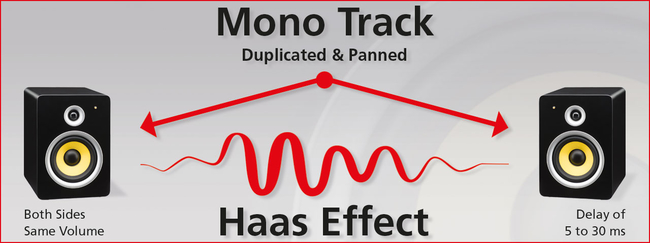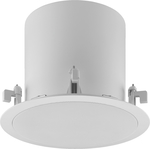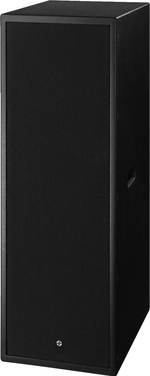
Haas effect, Franssen effect, room modes and double bass arrays
4 exciting concepts from the field of (psycho)acoustics and what you should know about them
Acoustics and PA technology could be so exciting if it were not for all the technical terms. In this article, newcomers, interested parties, music enthusiasts and anyone with an affinity for acoustics will learn about the Haas effect and the Franssen effect, how room modes blur the sound and why double bass arrays can be the solution. What is it that interests you most?
The Haas effect: the direction from which we perceive sound is determined solely by the direct sound we heard first
The Haas effect describes the following phenomenon: if a person hears two sounds with a delay of less than 40 milliseconds (below the human echo threshold), then that person perceives them both as a single sound. This is related to how we, as listeners, determine the spatial position of a speaker by sound (simply put: where we think the sound is coming from). Since two sounds with a very short delay are perceived as one sound, the spatial position is determined by the first and dominant sound. This is completely independent of where the second sound comes from. In other words: we locate the source of a sound by what reaches our ears first. Everything that follows, conveys a sense of depth and spaciousness, but we do not perceive it as an individual sound.
Where is the Haas effect relevant in practice?
So, with a delay of 35 milliseconds, you can broaden the stereo image of an otherwise 'flat' mono track and add dimension, entirely without using reverb or an imaging plug-in. By using the Haas effect, you create a wider stereo image. The effect is suitable for a wider mix with more depth on theatre stages, in restaurants and bars or just anywhere where there is a stationary audience. By the way, you can read the Haas effect upside down: longer delays between sounds create distinct repetitions and a greater sense of directionality.
“With regards to PA applications in exhibitions or on theatre stages, where does the Haas effect differ from simple panning?”
Panning is the tool of choice to give direction to the mix. However, while pan pots control the volume of each channel, the use of delays (which is nothing other than a 40 ms delay) controls the timing of each channel. Since people perceive both the intensity and timing of sounds, using the Haas effect can produce particularly effective results. Here is an example:
- Duplicate a mono audio track.
- Make a hard panning to the left and right.
- Just add a short delay to one of the tracks.
- Experiment with the delay time. There are clear differences, which are also a matter of taste. The Haas effect sets in from about 10 milliseconds on.
The Franssen effect: secretly moving sound sources
The Franssen effect is a spatial illusion. That effect only occurs in rooms where sound reflections are possible. The Franssen effect appears when a narrow-band stimulus (in our case a sound) comes from two speakers that are turned towards each other at an angle of ±45º. Attention: the Franssen effect only works if the room is not anechoic.
The Franssen effect causes the following phenomenon:
There is one speaker to the left and one to the right of the listener. Both are at least one metre away from the listener. The listener is therefore clearly outside the reverberation radius of the speakers. Now let us conduct a little experiment:
- Both speakers reproduce sounds with a constant level and in a constant spectrum (for example single tones). So far, so normal.
- Now the left speaker begins to produce a sharp, abrupt and loud pure tone. The listener will notice this and correctly attribute the sound to the left speaker.
- We use a crossfade to move the sharp and loud pure tone from the left speaker to the right. And we do this carefully and, above all, evenly: the two speakers change their volume complementarily to each other; when one increases by X, the other decreases by exactly X.
- When the tone has completely migrated to the right speaker, this speaker is much more dominant, much louder, but the listener will not notice this. Although the right speaker reproduces the entire sound in the end, the auditory impressions remain at the position of the left speaker for the listener.
This mislocalisation persists even when the test supervisor demonstratively unplugs the cables from the left speaker - a very impressive acoustic illusion. The effect is easiest to demonstrate for sounds in the frequency range of 1.0 to 2.5 kHz.
Incidentally, this only works for a narrow-band sound or a pure tone (such as a 1,000 Hz tone). In case of a broadband sound, the sound is suddenly heard in one ear and then 'jumps' to the other ear for the rest of the sound. As a reminder, broadband or HD sound is a (widespread) colloquial term for sound qualities of 7 kHz or higher.
What does the Franssen effect show us?
This effect provides some information on how we humans localise sound sources in enclosed rooms:
- The human ear is able to localise a sound source in reverberant sound fields if there are rapid signal changes or signal starts. The listener correctly assigns the sharp sound to the left speaker at the beginning of the experiment.
- The human ear is apparently not able to localise signals with constant amplitude and spectrum in reverberant sound fields. The listener did not detect the crossfade to the right speaker.
- Derived from point 2: as long as no new sound source is localised, the direction of the last localised sound source (left speaker) remains the perceived direction.
"The Franssen effect shows that we rely on the onset of sound to localise sound sources."
The explanation: at the beginning of the experiment, when the left speaker started to sound, there was a short period of time in which only the direct sound from the left speaker reached the left ear of the listener, i.e. without reflections from the wall. There was only the sound between the speaker and the left ear. During this time span, the listener could reliably localise the sound source, as there was no interference by wall reflections. A few milliseconds later, the sound from wall reflections also reached both ears of the listener and disturbed the localisation of the sound sources. But the listener still remembered the sound coming from the left speaker.
During the crossfade, level and spectrum of the radiated sound remained constant. Keep in mind, it was a complementary crossfade. This crossfade was superimposed by many wall reflections of the previous sound situation.
"In short, the auditory system localises sound sources in reverberant environments only at the onset of sound or in the event of major spectral changes. Wall reflections prevent localisation completely."
As long as no new localisation is possible, the auditory system seems to retain the last localised direction as the perceived sound source direction. Is the Franssen effect of any use in professional practice? Not so much. It is rather the tip of the iceberg when it comes to confusing auditory impressions in reverberant environments. Because these always make the localisation of sound sources particularly difficult.
Room modes: standing sound waves with a natural frequency in enclosed rooms
All rooms have naturally occurring resonant frequencies. In technical jargon, this is called 'room modes' or 'standing waves'. On the Internet you can also find other terms, such as 'natural oscillations' or 'eigenmodes'. Room modes are the main cause of acoustic distortions and cause peaks and dips of 20 dB or more in the frequency response. The resonances that generate such room modes are, in turn, called modal resonances. These modal resonances store (sound) energy and fade slowly compared to adjacent frequencies. This in turn leads to audible problems such as the 'one note bass' and the typical booming.
If you are unhappy with the performance of your home theatre, listening room or recording studio in the bass and lower midrange frequencies, it is very likely that the problem is related to the negative effects of modal resonances.
What causes room modes?
Room modes occur when a sound wave spreads between two opposing walls, for example between the left and right side walls or the floor and ceiling. The first modal resonance occurs at the frequency where the distance between the two boundaries is equal to half a wavelength. If a room is about 12 m (40 ft) long, the first modal resonance will be at 80 Hz. Further resonances occur accordingly at multiples of this frequency.
Are room mode calculators the solution?
Room mode calculators predict the frequencies at which modal resonances occur. For rectangular rooms, room modes can be easily predicted from the length, width and height dimensions. From the results generated by the calculator, you can see which peaks the room modes will cause on a frequency response measurement.
An example of peaks in the frequency response that are not caused by room modes are speaker boundary interferences. You should not rely too much on these calculators. Two rooms with the same dimensions but different materials and furnishings may lead to different results.
"The actual room modes are also affected by walls with doors, windows and other deviations."
In addition, these calculators reach their limits if the spaces are not rectangular, but open-plan or L-shaped instead. This is where the boundary element modelling (BEM) comes in handy. You can find an example of a calculator here or also here.
How can I identify modal resonances through acoustic measurements?
You can spot signs of modal resonances in measurements in three areas:
A narrow peak in the frequency response.
Slow fading in the time domain.
Changes in frequency response and time domain behaviour at different points in the room.
How do I reduce the effects of modal resonances?
There are a number of different solutions to room modal problems:
Acoustic treatment.
Positional equalisation: changing of listening positions and speakers/subwoofers.
Electronic equalisation.
Room mode cancellation.
Double bass arrays: eliminating room modes between side walls and between floor and ceiling
A double bass array (DBA) consists of two identical arrays of subwoofers, one array in the front and one in the rear. The subwoofers must be mounted in specific positions on the wall. For example, if you have four speakers in an array (i.e. eight in total) arranged in a square, their correct position is at 1/4 and 3/4 of the length and height of the wall. The side walls act like mirrors and have the same effect as equidistant bass sources. Thus, room modes between the side walls and between the floor and ceiling will be completely eliminated. In this arrangement, the front array creates a plane wave that spreads through the room. When it reaches the rear wall of the room, the second subwoofer array produces the same signal but with inverted polarity.
"A major advantage of the double bass array is that the bass affects a large area, not just one listener, with this arrangement. Perfect for cinemas or stages."
The trick is to use the rear array to delay the time it takes for the sound to travel from the front array to the back
You can achieve such a delay by using DSP equalizers. As a rule, the level of the rear array has to be somewhat lower than the level of the front array, because in practice there is always a small loss in the expansion of the wave due to the properties of the room. It helps if the subwoofer features a shallow depth and is ideally mounted directly into the mounting wall.
"This way, both waves cancel each other out and there is no reflection from the rear wall. The bass is thus completely free of room modes."
Double bass arrays also work with a higher or lower number of speakers per wall
The only important thing is that the distance between two speakers is twice the distance between the speaker closest to a side wall and the side wall itself. If you want to use only two speakers per array, they have to be mounted at 1/4 and 3/4 of the room width and midway between the floor and the ceiling.
So, you can elegantly hide the subwoofers in the wall or in a shelf.
So, you can elegantly hide the subwoofers in the wall or in a shelf.
Are you interested in more audio know-how? Feel free to browse our magazine for installers, planners and audio enthusiasts.
Source header graphic: © Pavel Losevsky - Adobe Stock




